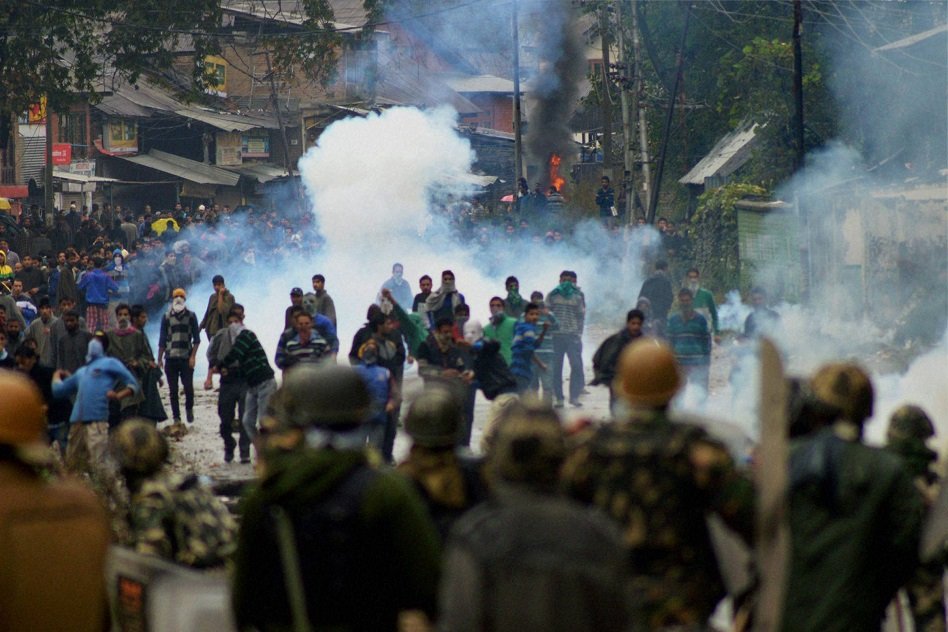
Kashmir Unrest Enters Its 100th Day. What Has Been Going On, What Might Be On The Cards
14 Oct 2016 2:56 PM GMT
July 8, 2016. This particular date would be remembered as one of most significant dates of this year, the date when fresh unrest sparked in the Kashmir valley with the killing of Hizbul Mujahideen commander Burhan Wani. Over three months have passed since the incident, and as the unrest enters its 100th day today, the situation is far from normal.
Curfew remains in force in five police station areas of downtown Srinagar. Curbs on the movement of people in the police station areas of Nowhatta, Khanyar, Rainawari, Safakadal and Maharaj Gunj have been imposed as a precautionary measure to maintain law and order. Restrictions on the assembly of people under Section 144 CrPc are in force throughout the Valley. As many as 84 people have been killed so far, more than 13,000 have been injured, and 7,000 have been arrested with over 300 of them booked under the controversial Public Safety Act. The use of much criticised and debated pellet guns have resulted in over 1,000 severe eye injuries.
Shops, business establishments, petrol pumps and educational institutions remained closed, while public transport continued to be off the roads.
Here are the significant consequences that have taken place so far:
The Kashmir unrest this year has so far taken 84 lives, and over thousands lay injured. The death is speculated to rise as many sustaining injuries may succumb to the blows due to lack of proper healthcare facilities in the Valley.
Stone pelting
Kashmir’s youth resorted to the pelting of stones to show their dissent against the armed forces. However, the arrest of 300 suspected instigators of stone-pelting by the Jammu and Kashmir police over the last three months has drastically reduced the number of such protests.
Pellet gun injuries
One of the most controversial topics of this unrest has been the use of pellet guns by armed force against the mob of stone pelters. However, pellet guns have not only been targeted on the stone pelters but also the innocent kids and women. Over thousands of people have sustained injuries from stone pelting. As many as 820 of those have undergone treatment at the Ophthalmology unit of Srinagar’s Shri Maharaja Hari Singh (SMHS) hospital, around 80 per cent of the injured were aged 26 or less, while a good 30 per cent aged 15 or less. According to records, 457 people had “multiple structural damages” in the eyes and required a vitrectomy and more than two surgeries.
Schools shut down
Schools across the Valley have been shut since summer break in July since the time violence erupted. Seven institutions are still occupied by troops as the government has failed to find accommodation for them elsewhere. Coaching centres have also been targeted in the violence.
In the absence of formal schooling, volunteers across Kashmir have set up community schools. Though such schools may not cater to a majority, they have come as a reprieve to parents and students. Despite such grave situation, state government has said board examinations for Class 10 and Class 12 will be held in November, much to the confusion and anger of students and teachers.
People going underground
A trend has been seen that over hundreds of young Kashmiris have gone underground in the last 100 days. They have completely disappeared. While some of them have gone to escape arrests, it is speculated that many have disappeared to join militant groups, particularly in South Kashmir. A majority of them had joined the stone-pelting movement after Burhan Wani’s death.
Media Blackout
Mobile internet services were suspended in Kashmir as well as in Jammu region to prevent the rumour-mongering. Many newspapers are also facing the ban by the government after fresh tensions escalated in the valley.
Public Safety Act
Over 300 persons have been booked so far under Public Safety Act (PSA). PSA provides for arresting and jailing a person without trial for two years on mere suspicion that he/she may disrupt law and order in the state or may act in a manner prejudicial to the security of the state. The Act bypasses all the institutional procedures and human rights safeguards of ordinary criminal justice system in order to secure a long detention term.
Way Forward
The situation in Kashmir has become much more than what it was perceived following the circulation of hackneyed opinions and arguments across media, the Uri attacks and surgical strikes. Somewhere down the line, a deep introspection is required by the government on why Burhan Wani’s death became a catalyst to such violence. Why did over two lakh people attend his funeral? The crisis that is mostly home-grown this time, has to be addressed with proper political mettle as it is a true fact that the Kashmiris are disappointed with the prevailing situation in the valley.
Using force against school children between 8-12 years will not be able pacify the residents of the Valley. Initially, the government had thought that applying force would be able to put the rebels aside. But, Kashmir today is preparing for some greater portents. A new wave of protests has taken its wing now. Eid, Independence day, Eid-ul-Adha, every occasions are over, but all hopes have trickled down to settle this ongoing tension.
Somehow the government has to win over the youth of Kashmir, and that has to be done without exercising force. Detachment to India is becoming the mindset of Kashmiris, which is a more frightening prospect. Chief Minister Mehbooba Mufti and her cabinet have barely shown any political or diplomatic acumen to deal with the situation. Even a growing disinterest and no political acumen have been shown by the central government to deal with it.
 All section
All section













